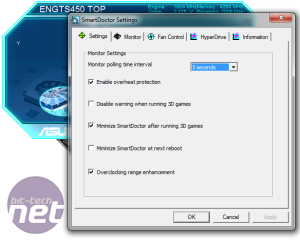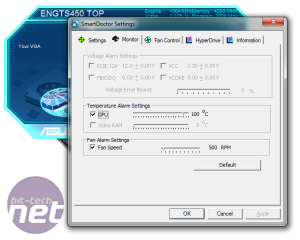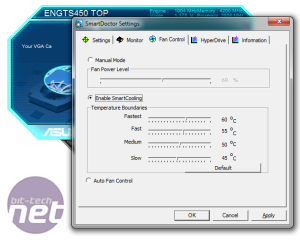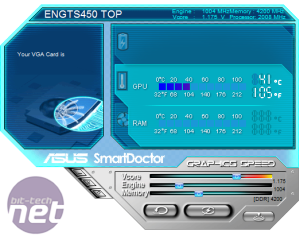Asus Smart Doctor, Overclocking Software
Like most of Asus' line of graphics cards, the GTS 450 Top includes the option to voltage tweak the GPU core. This is controlled via its Smart Doctor software. We've chastised the software in the past for being head-bangingly frustrating and sadly it's still terrible. However, the ability to adjust the card's core voltage does actually work.Trying to ignore the fact it looks like the design team was tutored by Picasso in his 'Transformers' phase, the dials are too small and fiddly to easily or even accurately control. They can't be nudged with the arrow keys either, as most other overclocking software allows.
Thankfully it's not all bad though, as hidden in the separate options box are other useful features such as fan-speed adjustment which includes a rather nifty "if temp = x then set this speed". Why this couldn't be out on the main program screen instead of the useless gif animation on the left is beyond us. Frankly, given that Asus has had ample time to develop its Smart Doctor software, it's ridiculous considering this should be its crowning asset - much like EVGA's fantastic Precision and MSI's AfterBurner software.
Overclocking
Biting our lip to use the Asus Smart Doctor software, we cranked the core frequency upwards. We found our sample would hit the 1GHz mark pretty easily, with a GPU voltage of around around 1.16V. However it wasn't stable until we pushed this to 1.176V, which also caused the GPU temperature to jump considerably during testing.Unfortunately beyond 1.16V, the Asus software and hardware does not offer particularly fine adjustments and the voltage jumps from 1.176V to 1.187V which results in a dramatic increase in heat output.
What's strange is that despite the heat increase, Asus' 4-pin PWM fan didn't crank up to counteract the extra heat generated; in the end we manually set the fan to compensate. It's worth pointing out that above 70 per cent speed the normally sedate and very quite fan
sounded like an intolerably noisy hair dryer. That's not unexpected though, as we were pushing the whole card to its absolute limit - at least at its normal 925MHz GPU core speed the fan was extremely quiet, even when gaming.
The card's memory also proved open to some extra overclocking and we managed to push the memory speed up to 4.2GHz effective, 400MHz higher than the memory of a stock GTS 450. This sort of increase isn't unheard of when using the standard memory though, so we were a little disappointed that Asus' Samsung GDDR5 modules couldn't be pushed any faster without compromising on stability.

MSI MPG Velox 100R Chassis Review
October 14 2021 | 15:04













Want to comment? Please log in.